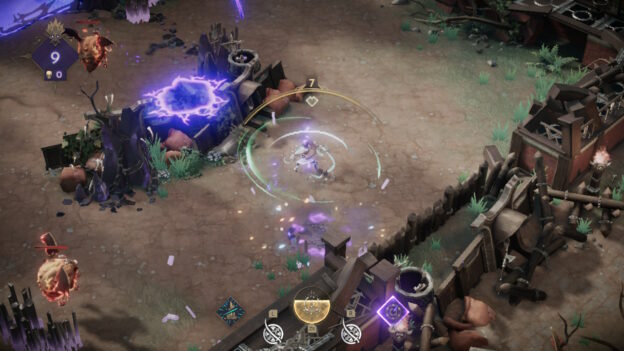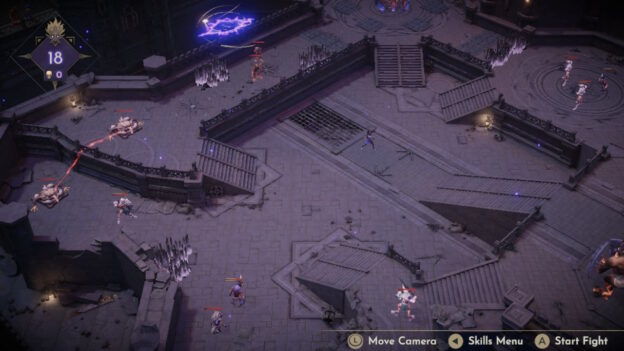Lysfanga: The Time Shift Warrior is an action-adventure game developed by Sand Door Studio and published by Quantic Dream. Its unique twist on hack ‘n’ slash is the game’s best feature…but that’s about it.

You play as Imë, the Lysfanga of the New Kingdom. The Goddess gives you the powers to rewind time and reincarnate yourself to build an army of clones. Through this power, you can defeat vast hordes of enemies, known as Raxes, in battle after battle throughout the game.
The story follows Imë as she explores the Kingdom, hopping from one battle to another, piecing together what happened to the Kingdom in the past and what is happening now. Usually, I’d be super into this lore, but Lysfanga: The Time Shift Warrior missed the mark for me. Exposition is sprinkled throughout narrative quips between Imë and her robotic allies. There are also various statues and other areas in the world to look at and get the characters to explain more.

I wasn’t interested in this. First, the villain is known as The Stranger throughout the game until the end. I couldn’t connect with him as a bad guy or care about why he was doing what he was doing. Second, a log keeps track of the enemies, characters, lore, etc. The story felt more like a “collectible” for the log rather than solid lore to intrigue the player.
I appreciated the Kingdom for its graphics rather than its story. It’s a shame that exploration is woefully narrow. The Kingdom is empty (rightfully so since the Raxes took over), but the scenery still looks nice. However, the game is linear, only allowing you to go in one direction. If you don’t hit an invisible wall and the way you go isn’t progress to the next battle, you’ll walk a long way to a dead end with a treasure chest or other collectible, which can be traded in to change Imë’s outfit.

And no, the outfits don’t upgrade Imë at all. They’re purely aesthetic. Imë doesn’t have defense, strength, health, or anything of that nature. The only upgrades you receive throughout are what you find in chests and what the Goddess gives you as you progress.
The Goddess will provide you with four powers, each being a powerful attack against the Raxes with cooldown time. Your robot friends will give you spells, ranging from extra attacks to defensive moves. You’ll also find runes in those chests, similar to spells. For example, one rune will quicken your cooldown time on your Goddess powers and give you a strong backstab, just to name a couple. You can equip a total of one spell, one rune, and one Goddess power per battle. Mixing and matching those powers was fun, but I quickly found favorites and stuck with them for most of the game.

Extra powers aside, the heart of the game is the battles themselves. Imë can rewind time. Each time she does, a clone of herself, known as a Remnant, appears, mimicking her previous movements. The battles themselves are hack ‘n’ slash, but they have a lot of strategy. Not to mention, the battles are timed, and the clock ticks faster each time you rewind.
Before each battle, you’ll see the whole field and where the Raxes are located. This is the time to strategize where to start and how many enemies you want to defeat before rewinding time. The clones will repeat what you just did so you can move on to other enemies.

In addition, each battle has a gimmick. Some battles are small, and others cover a vast area. Doors may be a feature where you go through a purple door, and all the other purple doors will close while yellow doors will open. Remnants can go through closed doors but still activate them to open and shut. I got myself stuck behind doors many times because keeping track of the Remnants was challenging. You earn more Remnants for every four shards you find. You’ll also get a freebie after defeating a boss. By the end of the game, I had 13 of them.
Raxes have gimmicks, too. Some can only be defeated by being hit in the back, while others are “twins” and are connected. You kill one, and the other will heal it, so you must kill both simultaneously. And yes, the twins are often at opposite ends of the battle area, so you need two Remnants to work together, timing it just right.

As you progress in Lysfanga: The Time Shift Warrior, battles don’t get any easier. You earn more spells, runes, Goddess powers, and Remnants. However, instead of being able to master those skills, the game continuously throws new gimmicks at you each battle. A couple of battles before the boss, the Raxes could only be defeated by a particular weapon. Imë has a sword, rings, and a trident, so I had to swap weapons in the middle of combat. You can’t swap weapons unless you have a specific rune equipped, so it forced me to use a rune I didn’t want.
Lysfanga: The Time Shift Warriors forces you to use your whole arsenal throughout the game. In the beginning, this is fine. I want the game to show me different ways to utilize my skills and abilities. However, by the end, especially for a hack ‘n’ slash game, I want to use my favorites and button-mash my way to victory. And, with the rewind and Remnants, there’s still plenty of strategy to go around, so I wouldn’t lose the main point of the battle mechanics.

Regardless, I did have a good time with the game. I beat the main story in under 14 hours. I wish I had gotten more into the story and the world-building. However, the game only allows Imë to move from one battle to another, occasionally finding chests if you look hard enough. The game crashed on me a few times and lagged occasionally, which was annoying. However, it autosaves so often that it was never a loss.
Review: Lysfanga: The Time Shift Warrior (Nintendo Switch)
Fair
Overall, Lysfanga: The Time Shift Warrior is a solid game. The strategy portion mixed with the hack ‘n’ slash was well done, though I didn’t care for the game forcing you to switch up your gameplay style throughout the entire experience.


